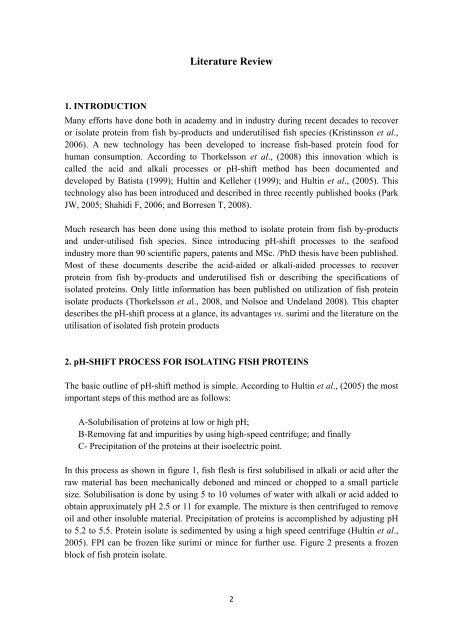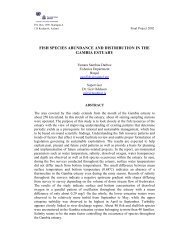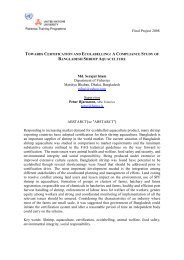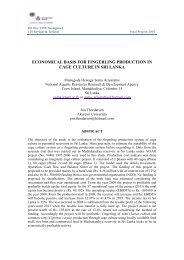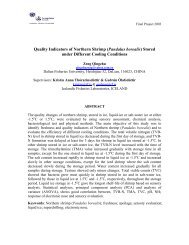Evaluation and Utilisation of Fish Protein Isolate Products
Evaluation and Utilisation of Fish Protein Isolate Products
Evaluation and Utilisation of Fish Protein Isolate Products
- No tags were found...
Create successful ePaper yourself
Turn your PDF publications into a flip-book with our unique Google optimized e-Paper software.
Literature Review1. INTRODUCTIONMany efforts have done both in academy <strong>and</strong> in industry during recent decades to recoveror isolate protein from fish by-products <strong>and</strong> underutilised fish species (Kristinsson et al.,2006). A new technology has been developed to increase fish-based protein food forhuman consumption. According to Thorkelsson et al., (2008) this innovation which iscalled the acid <strong>and</strong> alkali processes or pH-shift method has been documented <strong>and</strong>developed by Batista (1999); Hultin <strong>and</strong> Kelleher (1999); <strong>and</strong> Hultin et al., (2005). Thistechnology also has been introduced <strong>and</strong> described in three recently published books (ParkJW, 2005; Shahidi F, 2006; <strong>and</strong> Borresen T, 2008).Much research has been done using this method to isolate protein from fish by-products<strong>and</strong> under-utilised fish species. Since introducing pH-shift processes to the seafoodindustry more than 90 scientific papers, patents <strong>and</strong> MSc. /PhD thesis have been published.Most <strong>of</strong> these documents describe the acid-aided or alkali-aided processes to recoverprotein from fish by-products <strong>and</strong> underutilised fish or describing the specifications <strong>of</strong>isolated proteins. Only little information has been published on utilization <strong>of</strong> fish proteinisolate products (Thorkelsson et al., 2008, <strong>and</strong> Nolsoe <strong>and</strong> Undel<strong>and</strong> 2008). This chapterdescribes the pH-shift process at a glance, its advantages vs. surimi <strong>and</strong> the literature on theutilisation <strong>of</strong> isolated fish protein products2. pH-SHIFT PROCESS FOR ISOLATING FISH PROTEINSThe basic outline <strong>of</strong> pH-shift method is simple. According to Hultin et al., (2005) the mostimportant steps <strong>of</strong> this method are as follows:A-Solubilisation <strong>of</strong> proteins at low or high pH;B-Removing fat <strong>and</strong> impurities by using high-speed centrifuge; <strong>and</strong> finallyC- Precipitation <strong>of</strong> the proteins at their isoelectric point.In this process as shown in figure 1, fish flesh is first solubilised in alkali or acid after theraw material has been mechanically deboned <strong>and</strong> minced or chopped to a small particlesize. Solubilisation is done by using 5 to 10 volumes <strong>of</strong> water with alkali or acid added toobtain approximately pH 2.5 or 11 for example. The mixture is then centrifuged to removeoil <strong>and</strong> other insoluble material. Precipitation <strong>of</strong> proteins is accomplished by adjusting pHto 5.2 to 5.5. <strong>Protein</strong> isolate is sedimented by using a high speed centrifuge (Hultin et al.,2005). FPI can be frozen like surimi or mince for further use. Figure 2 presents a frozenblock <strong>of</strong> fish protein isolate.2


